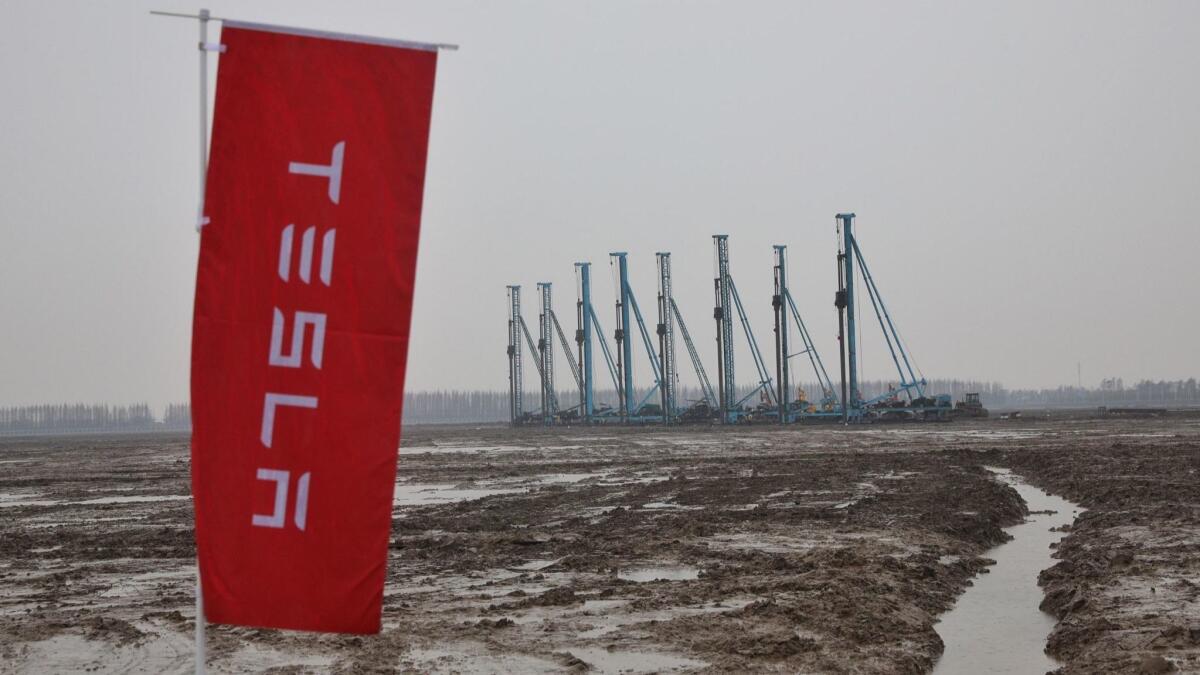Tesla rushes Model 3s to China before trade war truce expires

At least three ships roughly the length of two football fields are scheduled to arrive at ports in China by the end of this month, each carrying precious cargo from Tesla CEO Elon Musk.
Tesla Inc. is loading as many Model 3 sedans as it can onto vessels destined for the People’s Republic ahead of March 1, when a trade war truce between presidents Trump and Xi Jinping is scheduled to expire. Musk fears the two countries could ratchet tariffs back up, which would make Tesla’s electric cars more expensive in China and boost costs of key components the country sends to its U.S. assembly plant.
Other carmakers are at risk of seeing expenses rise again if the Trump-versus-Xi dispute flares back up. But Musk is in perhaps the most precarious position in the industry. Global giants such as BMW and Daimler can wiggle around the tariffs to an extent by boosting production at existing China factories, but Tesla’s manufacturing presence there was merely a muddy field as of last month. It won’t be assembling any vehicles in China until the end of 2019 at the earliest.
“They’re uniquely exposed,” said Robin Zhu, an analyst at Sanford C. Bernstein.
Musk, 47, said getting cars to China before a potential increase in tariffs was a key priority when Tesla reported a smaller-than-expected profit Jan. 30. Higher duties would combine with already elevated transport and labor costs to make the company’s vehicles much pricier than competitors’. Plus, imported electric cars aren’t eligible for local tax credits.
“Our car is just very expensive going into China,” Musk said on the earnings call. “The demand for Model 3 is insanely high. The inhibitor is affordability.”
Musk has a case to make that Tesla punches above its weight on trade. Although researcher Autodata Corp. estimates that the carmaker’s U.S. market share was only about 0.7% last year, U.S. Census Bureau data suggest the company may account for almost 16% of vehicle exports by value.
In 2017, California shipped $1.37 billion worth of electric vehicles to China, according to the bureau’s foreign-trade statistics. Through October 2018, the figure was $936 million. Virtually all of those cars were Teslas.
Trump and Xi agreed to a 90-day detente in December. The U.S. said it would delay a planned tariff rate increase — to 25% from 10% — on almost half the goods it buys from China, worth some $200 billion. Although officials have been negotiating since then, Trump has said he and Xi won’t meet again before March 1.
On Tuesday, Trump said he’s open to extending the deadline if the two sides are near an agreement. China has said its suspension of an additional 25% tariff on U.S. autos and parts will apply through the end of March. For months before the truce, China had slapped American-built cars with 40% levies.
In recent days, a steady stream of trucks hauling Tesla models has arrived at the gates of Pier 80 in San Francisco, where workers can be seen unloading them into a parking lot packed with thousands of cars. The vehicles then are loaded onto ships for the roughly two-week journey to Asia.
The vessel Glovis Symphony docked at the port of Tianjin early this week and was due to arrive in Shanghai on Wednesday. Two more carriers, Morning Cindy and Emerald Ace, are at sea and scheduled to reach China’s shores on Feb. 19 and 24, according to data compiled by Bloomberg. Other ships being loaded at Pier 80 are headed to Europe.
The Model 3 is the linchpin of Tesla’s effort to appeal to a wider global audience, with Musk promising for years that a version eventually will be available for $35,000 before incentives. That’s generally in line with the average selling price of a vehicle in the U.S.
But following through on that vow has bedeviled Musk. The cheapest version available now — almost three years since he first showed a concept of the car — is $42,900. In Europe, where deliveries are just getting underway, prices vary by country, with customers in Belgium paying a base price of 58,800 euros ($66,600), compared with 55,400 euros in Germany and 53,500 euros in France.
In China, the Model 3 starts at 433,000 yuan ($63,900). Some of the bestselling electric cars in the market — the world’s biggest for battery-powered vehicles — can be had for less than a sixth of that price. Beijing Electric Vehicle Co.’s EC Series and Chery Automobile Co.’s eQ are listed at 65,800 yuan after subsidies.
The U.S.-China trade war risks making the Model 3 costlier worldwide. In addition to the possibility that Xi’s administration could reimpose higher tariffs on American autos, Trump’s levies could make it more expensive for Tesla to source key parts.
Tesla asked the Trump administration for a tariff exemption on the Model 3’s computer, which is made in China and essentially acts as the brain of the car, overseeing everything from the touch-screen display to the advanced driver-assistance system known as Autopilot.
The U.S. trade representative’s office has been reviewing whether the product is available only from China and whether higher tariffs would severely hurt the company or U.S. interests. Tesla argued as much in its request, filed in August.
If the trade war escalates further, Tesla could shift part of its supply chain to other countries in Asia, or to Mexico, where it already has several established suppliers. The company also is working closely with government officials in Shanghai to build a vehicle and battery factory. Musk said he expects to make several trips to China this year.
“We’re thinking about demand almost zero right now,” Musk said during the earnings call. Getting cars to China before there’s a potential rise in tariffs is “really on top of mind.”
More to Read
Inside the business of entertainment
The Wide Shot brings you news, analysis and insights on everything from streaming wars to production — and what it all means for the future.
You may occasionally receive promotional content from the Los Angeles Times.










